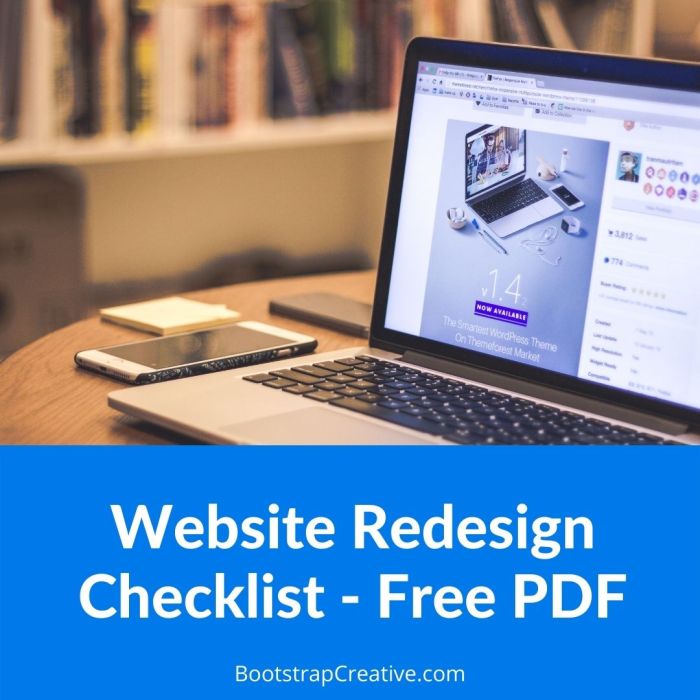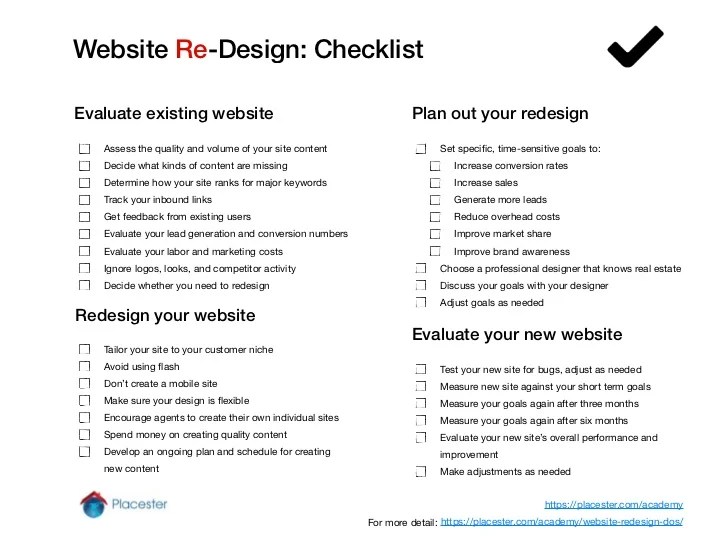Website Redesign Checklist dives into the essential steps needed to revamp your online presence, ensuring that your website stays current and engaging. From planning to visual design, this checklist covers everything you need to know to create a successful redesign project.
Importance of Website Redesign
When it comes to websites, staying current is key. A website redesign is not just about aesthetics; it’s about staying relevant in a fast-paced digital world.
Keeps Up with Trends
With technology constantly evolving, an outdated website can quickly fall behind. By redesigning your site, you can incorporate the latest design trends and features to keep your audience engaged.
Impact on User Experience and Conversions
- An outdated website can lead to a poor user experience, causing visitors to bounce off your site quickly.
- Modernizing your website can improve navigation, load times, and overall usability, leading to higher conversion rates.
Benefits for Branding and Credibility
- A fresh, modern website design can help strengthen your brand identity and make a positive impression on visitors.
- Having a professional-looking website instills trust and credibility in your audience, increasing the likelihood of them engaging with your content or services.
Planning and Preparation
Planning a website redesign project involves several key steps to ensure a successful outcome. One of the first and most important steps is setting clear goals and objectives for the redesign. This helps to define the purpose of the project and provides a roadmap for the redesign process. Additionally, conducting a thorough audit of the current website is crucial before starting the redesign.
This audit helps to identify areas for improvement, understand user behavior, and ensure that the redesign addresses any existing issues.
Setting Clear Goals and Objectives
When setting goals and objectives for a website redesign, it is important to consider the overall objectives of the business or organization. These goals should be specific, measurable, achievable, relevant, and time-bound (SMART). By setting clear goals, you can ensure that the redesign aligns with the broader objectives of the company and helps to drive desired outcomes.
This can include improving user experience, increasing conversions, boosting engagement, or enhancing brand perception.
Conducting a Thorough Audit
Before diving into the redesign process, it is essential to conduct a comprehensive audit of the current website. This audit should cover aspects such as site structure, content quality, user experience, performance metrics, , and design elements. By understanding the strengths and weaknesses of the existing site, you can make informed decisions about what needs to be improved or changed in the redesign.
This step is crucial for ensuring that the redesign effectively addresses any issues and delivers a better overall user experience.
User Experience Optimization

Improving user experience during a website redesign is crucial for keeping visitors engaged and increasing conversions. Responsive design plays a significant role in catering to the growing number of mobile users, while intuitive navigation and clear calls-to-action help enhance user engagement.
Best Practices for Improving User Experience
- Ensure fast loading times to prevent users from leaving due to slow performance.
- Optimize images and videos for quick loading on all devices.
- Create a clean and visually appealing design that is easy to navigate.
- Implement clear and concise content to provide valuable information to users.
- Use intuitive forms and checkout processes to streamline user interactions.
Significance of Responsive Design for Mobile Users
Responsive design ensures that your website looks and functions well on any device, providing a seamless user experience across desktops, tablets, and smartphones.
Role of Intuitive Navigation and Clear Calls-to-Action, Website Redesign Checklist
Intuitive navigation helps users find what they are looking for quickly and easily, reducing bounce rates and keeping them engaged. Clear calls-to-action guide users on the next steps to take, increasing conversions and overall user satisfaction.
Content Strategy
When it comes to developing a content strategy during a website redesign, it’s essential to take a thoughtful and strategic approach. Your content is what will engage visitors and keep them coming back for more. Here are some tips to help you craft a winning content strategy:
Auditing Existing Content
Before diving into creating new content, it’s crucial to audit your existing content. Identify what’s working well, what needs improvement, and what can be removed altogether. This step will help you streamline your content and ensure that everything aligns with your new website goals.
- Review all existing pages and posts to assess their relevance and effectiveness.
- Check for outdated information or broken links that need to be updated.
- Identify high-performing content that can be repurposed or expanded upon.
Creating Fresh Content
Fresh, relevant content is key to attracting and retaining visitors to your website. It’s essential to provide value through your content and keep it up-to-date to stay competitive in the digital landscape.
- Research s and topics that are relevant to your target audience.
- Create a content calendar to plan out your posts and ensure consistency.
- Utilize multimedia elements like videos, infographics, and images to enhance your content.
Visual Design and Branding

When it comes to website redesign, the visual design and branding play a crucial role in attracting and engaging users. A visually appealing website can leave a lasting impression on visitors and help convey the brand’s identity effectively.
Elements to Consider for a Visually Appealing Website Redesign:
- Color Schemes: Choose colors that complement the brand and evoke the right emotions in the audience.
- Typography: Select fonts that are easy to read and align with the brand’s voice and style.
- Imagery: Use high-quality images that resonate with the target audience and enhance the overall look of the website.
Importance of Aligning Design with Brand Identity:
Ensuring that the visual design aligns with the brand identity is essential for maintaining consistency and building brand recognition. By using colors, fonts, and imagery that reflect the brand’s values and personality, you can create a cohesive and memorable user experience.
Tips for Choosing Color Schemes, Typography, and Imagery:
- Research the psychology of colors to understand how different hues can impact emotions and perceptions.
- Experiment with font pairings to find a combination that is both visually appealing and easy to read.
- Use imagery that tells a story and connects with the audience on an emotional level.
Functionality and Performance: Website Redesign Checklist
When it comes to ensuring optimal functionality and performance during a website redesign, there are several key factors to consider. Testing features, forms, and links is crucial for providing a seamless user experience. Additionally, optimizing website speed and performance can lead to improved rankings and increased user satisfaction.
Testing Features, Forms, and Links
- Conduct thorough testing of all new features to identify and fix any bugs or issues before the website goes live.
- Test all forms to ensure they are functioning correctly and capturing data accurately.
- Regularly check and test all links on the website to prevent any broken links that can negatively impact user experience and .
Optimizing Website Speed and Performance
- Optimize images and multimedia content to reduce file sizes and improve loading times.
- Minimize HTTP requests by combining CSS and JavaScript files to reduce loading times.
- Utilize caching mechanisms to store static content and reduce server load, improving overall website performance.
- Implement a content delivery network (CDN) to distribute content across multiple servers, reducing load times for users in different locations.
